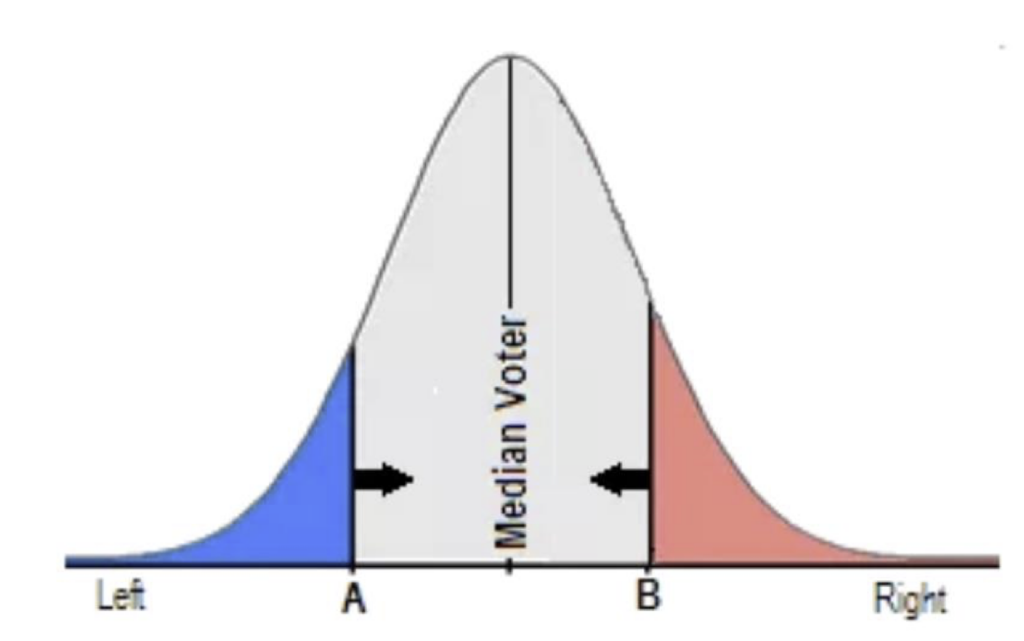On the Median Selector
A David Brooks column conjures up some thought.
·
Sunday 19 November 2023
· 13 feedback

David Brooks had a column the opposite day concerning the midterm outcomes versus the newest ballot relating to Trump v. Biden. It is titled Democrats: You Can Chill Out Now! I wasn’t going to touch upon all of it, however the next jumped out at me (that is how clearing tabs can take a number of phrases on one).
So right here we go. From Brooks:
The median voter rule nonetheless applies. The median voter rule states that events win after they keep near the middle of the citizens. It is one of the vital boring guidelines in all of politics, and typically folks left and proper faux they will ignore it, however they often find yourself paying a worth.
Democrats’ robust exhibiting in elections throughout the nation this week proves simply how highly effective the median voter rule is, particularly in terms of the abortion concern.
Okay, there’s really so much to unpack right here, and there isn’t any technique to cowl it multi function put up, however let me observe one thing that I feel is actually vital: the median voter “rule” (actually, what’s often known as the median voter theorem – though it is probably not a theorem, however extra of a mannequin or idea) could be very depending on the distribution of voters and subsequently on what the median of this distribution is*. Journalists, and infrequently folks normally who speak about such issues, have a tendency to speak as if we at all times have a standard distribution of voters by way of ideology (in order that the centrists are the large prime of the curve), and that is how we should perceive election outcomes.
Principally, the straightforward mannequin seems to be like the next and assumes a big middle the place the true left and proper are a lot smaller. Sure, it is a simplified mannequin, nevertheless it ought to give everybody an thought of what I am speaking about. The upper the curve, the extra voters on the given ideological level below that a part of the curve. On this distribution there are a lot of centrists, and actually the center of the distribution (the median, the place half of the voters are to the appropriate of that time and half to the left) is essentially the most centrist of the centrists (which sq. at like many, many , many pundits faux they exist and the place from which many columns craving for a third-party savior have been based mostly). Logically, an excessive left extremist would lose to a average, or perhaps a conservative, and vice versa.

So in such a distribution, the candidate who’s extra centered out of two is more likely to win. And if we assume that the American citizens seems to be like that, that is why columnists and third-party activists faux that the best way ahead is centrism. This was the logic of Ross Perot and to some extent folks like Joe Manchin and his No Labels (sure, it is a label) pals.
And infrequently that is how folks speak about American democracy, as if it is only one large, comparatively truthful contest, and the competition is (or needs to be) within the center.
One of many numerous causes I argue that the US has a democratic deficit is that no, it does not work that means.
First, if we take into consideration the US presidential election, the rationale (nicely, one in every of them) that the Electoral School is an issue is that it skews the result away from regardless of the median choice of all of the voters is. A nationwide common voter ought to really drive the electoral contest to roughly wherever the precise voter median is (which is not the excellent bell curve above, however for the sake of argument I am going to say it is not radically completely different).** However as an alternative it drives the method the competitors to a restricted variety of competing states.
I’ll observe that one of many causes that nationwide votes for president are an issue is that, as everyone knows, there are literally 56 particular person contests (50 states plus DC plus the 2 Maine and three Nebraska district elections ). The query subsequently turns into not what the nationwide median voter is, however what the median voter is in every of those elections. (By extension, that is true within the 50 Senate races and 435 Home races).
Second, because of this single-seat districts are an issue (exacerbated by gerrymandering). The median voter in state X may very well be extra average, however when you’ll be able to divide state X into e.g. seven segments, you may make positive to skew the consequence as distant from the state median to your occasion as attainable. And whereas the state’s districts are drawn in a nonpartisan method, they’re very more likely to skew away from the state’s total median choice resulting from inhabitants distributions.
Moreover, most US congressional districts could have curves that both peak considerably additional to the left or to the appropriate than the curve above.
I’ll observe that each the EC and the usage of single-member districts end in the place strains are drawn ending up being extra vital than the precise democratic preferences of voters. For this reason they impair democratic high quality and representativeness. Once more, the placement of the strains finally ends up being extra vital than the broader distribution of voter preferences.
Third, I might add that the primaries additional skew the query of whether or not the system actually drives competitors to the median. The median major voter virtually actually has a unique ideological profile than the median co-partisan on the district stage. However the median voter on the district stage will vote for his or her occasion’s nominee as a result of they’re nearer ideologically to them than they’re to their opponent’s candidate (or at the least, their partisan ID tells them that is the case, even when their district is a case by an MTG-like GOP candidate and average Democrat).
Relating to the final level, I might observe that partisan identification itself, as a normal matter, influences how voters understand candidates, that means that it’s attainable {that a} given candidate may very well be nearer to the median ideologically in a given district, however that voter perceptions are influenced by occasion manufacturers and the indicators they’re perceived to ship. This can be a giant a part of the rationale why even when, e.g. in a closely Republican district, a average and even center-right Democrat who may be nearer to the district’s ideological median goes to lose, regardless of pundit (and typically OTB commentator) fantasies on the contrary.
To Brook’s level, it’s clear that the median place in Ohio is pro-choice, however this isn’t a superb illustration of the median voter idea as a result of a referendum of this kind is about voter preferences on a single concern, not a voter’s guess as as to if candidate X or Y is nearer to the ideological median for a given district. Not solely is it a query that makes it simpler to find out the place the median preferences lie, however the mechanism of a easy sure/no alternative on a statewide poll by definition finds the median choice (roughly)—at the least it roughly identifies the place the median choice is is on the precise query being requested.
In actual fact, if the statewide competitors for e.g. Had the Senate been a pro-choice Democrat and a pro-life Republican, the result of that contest would have been a bit completely different, though abortion was the problem of that race (however it might nonetheless have just one variable in a much more complicated pot of points and views). It illustrates in easy phrases the distinction between a single concern election and a race between candidates even with the very same pool of voters.****
In spite of everything, Ohio was round +8 R in 2020 and JD Vance gained his Senate seat in 2022 with +6.1. The abortion reference handed +13.2. As such, what this doubtless tells us is rather more about abortion than it does concerning the acceptable software of the “median voter rule.” (Or at the least the potential limitations of utilizing it to seek out political readability).
A last aspect observe which opens up one other can of worms. It’s price contemplating to what extent we needs to be involved with merely having the nation’s median views represented, or whether or not we should always desire a system that proportionally represents your entire distribution of voters. All the dialogue above roughly assumes solely two selections and both majority choice or majority choice guidelines.
*If you’re at a celebration and 40% of the folks like pepperoni pizza, 20% like sausage, 20% like a mix of each, 10% need Canadian bacon, and 10% are vegetarian, and there’s a vote, it positively seems to be pepperoni to me. But when the breakdown is 70% vegetarian, 20% pepperoni, and 10% “we will not have hamburgers,” the vote will likely be very completely different.
**That is the place I observe that I’m scripting this for enjoyable on a weekend and never writing an actual educational thesis. If I do, the numbers could be significantly better!
***And I’ll danger being accused by some readers of being too shy within the sky and observe {that a} proportional illustration electoral system, even modest PR, may remedy this. This may be performed by Parliament by laws, relying on the system used. Yeah, it is a political non-starter in the intervening time, so I most likely should not even point out it!
****Notice that I mentioned “voter pool” and never simply “voters” since turnout impacts who the voters are even when all of them come from the identical pool.

